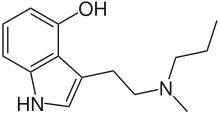Source: Wikipedia, the free encyclopedia.
4-HO-MPT
Names
Preferred IUPAC name
3-{2-[Methyl(propyl)amino]ethyl}-1H -indol-4-ol
Identifiers
ChemSpider
UNII
InChI=1S/C14H20N2O/c1-3-8-16(2)9-7-11-10-15-12-5-4-6-13(17)14(11)12/h4-6,10,15,17H,3,7-9H2,1-2H3
Y Key: XFQDDPQGBLSNCN-UHFFFAOYSA-N
Y InChI=1S/C14H20N2O/c1-3-8-16(2)9-7-11-10-15-12-5-4-6-13(17)14(11)12/h4-6,10,15,17H,3,7-9H2,1-2H3
Key: XFQDDPQGBLSNCN-UHFFFAOYAC
Properties
C 14 H 20 N 2 O
Molar mass
−1
Except where otherwise noted, data are given for materials in their
standard state (at 25 °C [77 °F], 100 kPa).
Chemical compound
4-Hydroxy-N -methyl-N -propyltryptamine , commonly known as 4-HO-MPT or meprocin , is a
MPT
.
History 4-HO-MPT was first synthesized and bioassayed by biochemist Alexander Shulgin and written about in his 1994 book TiHKAL [1]
Dosage and duration For psychedelic effects, the dosage and duration are listed as "unknown" in TiHKAL.[1]
Effects Very little data exists about the pharmacological properties, metabolism, and toxicity of 4-HO-MPT. In a single trial of 8 mg orally of 4-HO-MPT HCl from TiHKAL, it is described as producing visual distortion,
Legal status 4-HO-MPT is not scheduled by the United Nations ' Convention on Psychotropic Substances .[2]
United States 4-HO-MPT is not
References External links
1-Methylpsilocin 2,alpha-DMT
2-Me-DET 2-Methyl-5-HT 2,N,N-TMT 4,5-DHP-DMT
4,5-MDO-DMT 4,5-MDO-DiPT 4-AcO-DALT 4-AcO-DET
4-AcO-DMT 4-AcO-DiPT 4-AcO-EPT 4-AcO-NMT 4-AcO-MALT 4-AcO-MET
4-AcO-DPT 4-AcO-MiPT
4-F-5-MeO-DMT 4-HO-5-MeO-DMT 4-HO-DALT 4-HO-DBT 4-HO-DET 4-HO-DiPT 4-HO-DPT 4-HO-DSBT 4-HO-EPT 4-HO-MALT 4-HO-MET 4-HO-McPT 4-HO-McPeT 4-HO-MiPT 4-HO-MPMI 4-HO-MPT 4-HO-MsBT 4-HO-NMT
4-HO-PiPT 4-HO-pyr-T 4-HO-αMT 4-Me-αET 4-Me-αMT
4-MeO-DiPT 4-MeO-DMT 4-MeO-MiPT 4-PrO-DMT 5,6-MeO-MiPT 5,6-MDO-DiPT 5,6-MDO-DMT 5,6-MDO-MiPT 5,7-Dihydroxytryptamine 5-BT 5-Bromo-DMT 5-CT 5-Chloro-αMT 5-Chloro-DMT 5-Ethoxy-αMT
5-Ethoxy-DMT 5-Ethyl-DMT 5-Fluoro-AET 5-Fluoro-αMT 5-Fluoro-DET 5-Fluoro-DMT 5-Fluoro-EPT 5-Fluoro-MET 5-HO-αMT
5-HO-DiPT 5-HTP 5-iPrO-AMT 5-MeS-DMT 5-Methoxytryptamine 5-MeO-7,N,N-TMT 5-Methyl-αET 5-MeO-2-TMT 5-MeO-αET 5-MeO-αMT 5-MeO-DALT 5-MeO-DBT 5-MeO-DET 5-MeO-DiPT
5-MeO-DMT 5-MeO-DPT 5-MeO-EiPT 5-MeO-EPT 5-MeO-MALT 5-MeO-MET 5-MeO-MiPT 5-MeO-MPMI 5-MeO-NMT 5-MeO-pyr-T 5-MeO-NBpBrT 5-Methyl-DMT 5-(Nonyloxy)tryptamine 6-Fluoro-αMT 6-Fluoro-DMT 6-Hydroxymelatonin 6-MeO-THH 7-Chloro-AMT 7-Methyl-α-ethyltryptamine 7-Methyl-DMT Acetryptine Aeruginascin αET
Alpha,N-DMT α,N,N-Trimethyltryptamine Alpha,N,O-TMS AL-37350A αMT
Baeocystin BNC-210 Bufotenidine Bufotenin (5-HO-DMT) BW-723C86 Convolutindole A CP-132,484 DALT DBT Desformylflustrabromine DET DiPT
DPT E-6801 E-6837 Ethocybin EiPT EMDT EPT FGIN-127 FGIN-143 Harmaline HIOC Ibogaine Idalopirdine Indorenate Iprocin Lespedamine Luzindole MET Methylbutyltryptamine MiPT
MPT
Miprocin Melatonin MPMI MS-245 NAS N-Ethyltryptamine N-Feruloylserotonin NMT DMT Norbaeocystin Normelatonin N-t-Butyltryptamine O-4310 Oxypertine Plakohypaphorine PiPT Psilocin (4-HO-DMT) Psilocybin (4-PO-DMT) Pyr-T Rizatriptan RU-28306 Serotonin ST-1936 Sumatriptan Tryptamine Tryptophan Yohimbine Yuremamine Zolmitriptan

